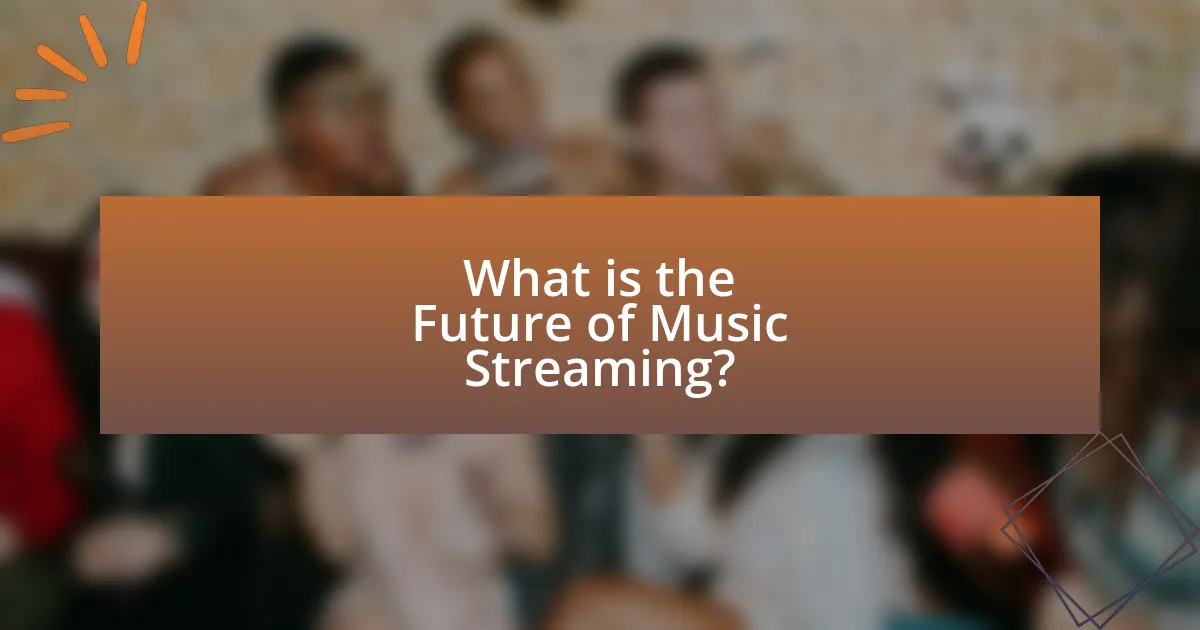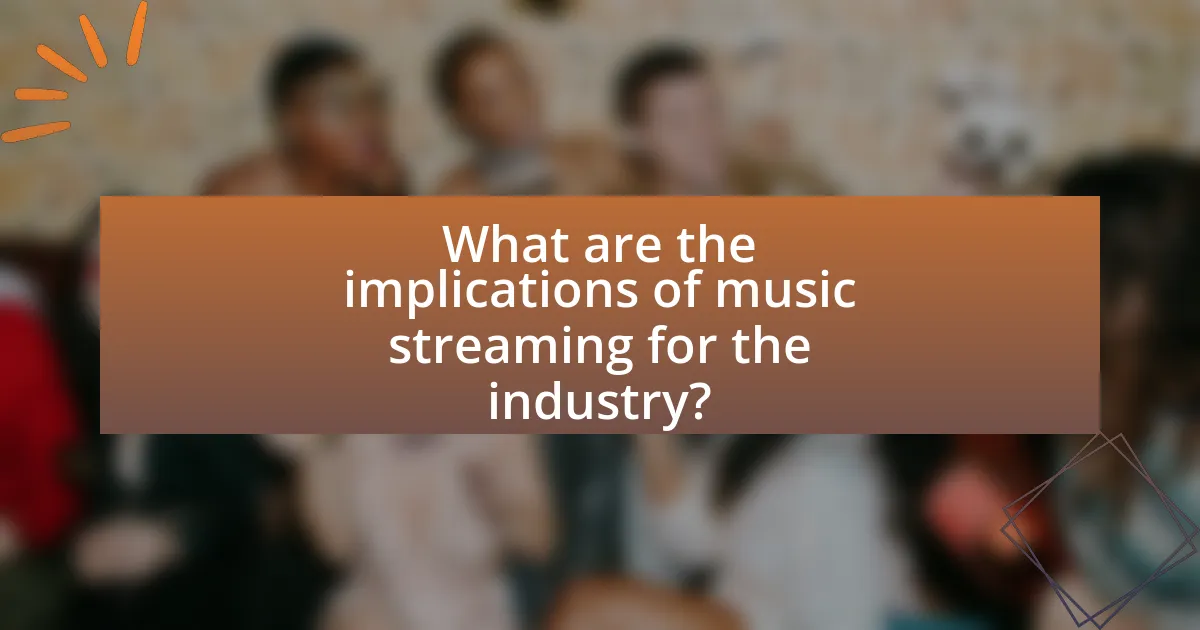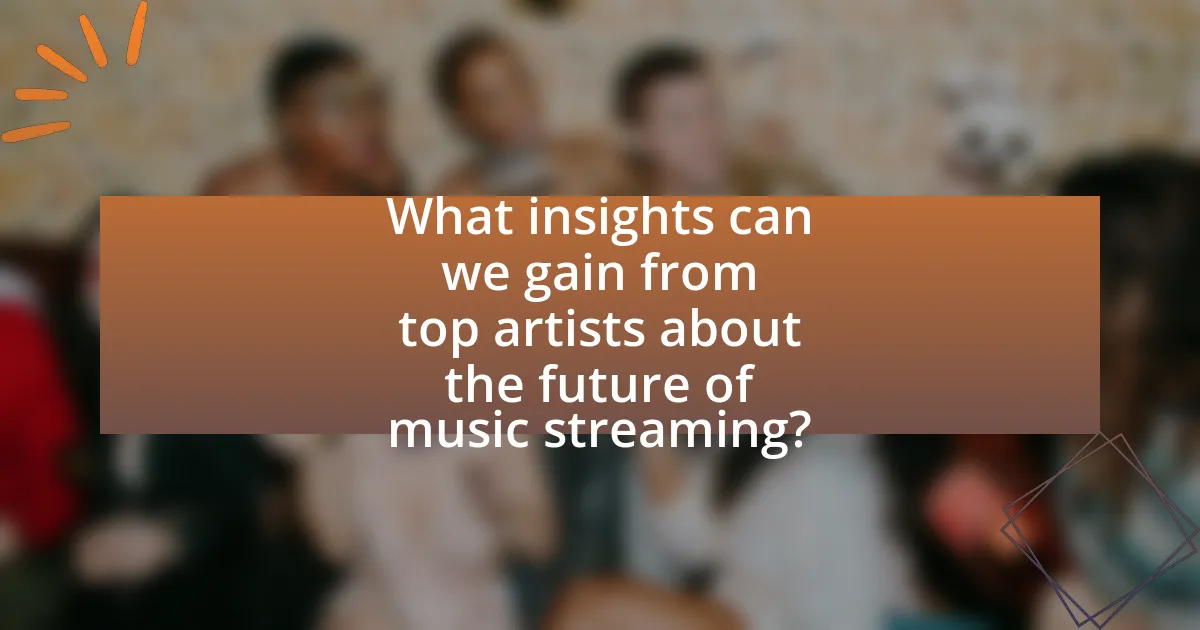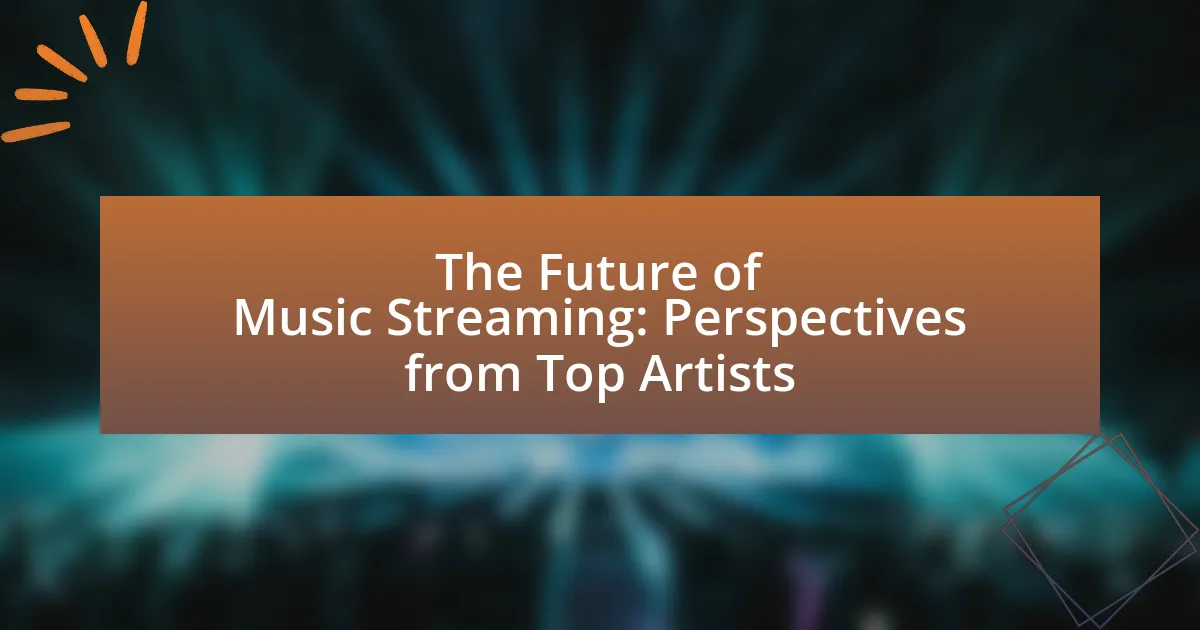The article focuses on the future of music streaming, highlighting the perspectives of top artists regarding industry trends and technological advancements. Key topics include the increasing personalization of streaming services through artificial intelligence, the evolving landscape shaped by consumer preferences, and the challenges artists face in terms of revenue and visibility. The article also examines the implications of streaming on artist compensation, diversity in music, and the role of social media in promoting new music. Additionally, it discusses potential future scenarios for music streaming, including innovations that could enhance the user experience and strategies artists can adopt to navigate this changing environment.

What is the Future of Music Streaming?
The future of music streaming is characterized by increased personalization, enhanced user experiences, and the integration of emerging technologies like artificial intelligence. As streaming platforms evolve, they are likely to leverage AI to curate playlists and recommend music tailored to individual listener preferences, improving engagement and satisfaction. According to a report by the International Federation of the Phonographic Industry (IFPI), 2022 saw a 21.5% increase in global streaming revenues, indicating a robust growth trajectory for the industry. Additionally, advancements in virtual reality and augmented reality may create immersive listening experiences, further transforming how audiences interact with music.
How is the landscape of music streaming evolving?
The landscape of music streaming is evolving towards increased personalization and integration of artificial intelligence. Streaming platforms are utilizing AI algorithms to analyze user behavior, enabling them to curate tailored playlists and recommendations that enhance user engagement. For instance, Spotify reported that over 30% of its listening hours come from personalized playlists, demonstrating the effectiveness of this approach. Additionally, the rise of social media integration within streaming services allows users to share music more easily, fostering community and discovery. This shift reflects a broader trend where user experience and interaction are prioritized, shaping the future of how music is consumed and shared.
What technological advancements are shaping music streaming?
Technological advancements shaping music streaming include artificial intelligence, machine learning algorithms, and improved data analytics. These technologies enhance personalized recommendations, optimize streaming quality, and enable better user engagement. For instance, AI-driven algorithms analyze user behavior to curate playlists tailored to individual tastes, significantly increasing user satisfaction and retention rates. Additionally, advancements in cloud computing allow for seamless access to vast music libraries, while high-resolution audio streaming technologies improve sound quality, catering to audiophiles. According to a report by the International Federation of the Phonographic Industry, the global music streaming market grew by 18.5% in 2020, largely driven by these technological innovations.
How are consumer preferences influencing music streaming trends?
Consumer preferences are significantly shaping music streaming trends by driving the demand for personalized content and user-friendly interfaces. As listeners increasingly favor curated playlists and algorithm-driven recommendations, platforms like Spotify and Apple Music have adapted their services to enhance user experience. For instance, Spotify’s “Discover Weekly” feature, which offers personalized playlists based on listening habits, has contributed to a 40% increase in user engagement, demonstrating how tailored content meets consumer desires for convenience and relevance. Additionally, the rise of social media integration, where users share music through platforms like TikTok, has influenced streaming trends by promoting viral hits and emerging artists, further aligning with consumer preferences for discoverability and community engagement.
Why is the perspective of top artists important in this context?
The perspective of top artists is important in the context of music streaming because they influence industry trends and consumer behavior. Their insights can shape the future of streaming platforms, as artists often drive the demand for new features and fair compensation models. For instance, a survey by the Music Industry Research Association found that 70% of artists believe their input on streaming policies is crucial for equitable revenue distribution. This highlights that top artists not only represent a significant portion of the content but also possess the authority to advocate for changes that benefit the entire music ecosystem.
What challenges do artists face in the current streaming environment?
Artists face significant challenges in the current streaming environment, primarily due to low revenue per stream. The average payout for artists from streaming services is approximately $0.003 to $0.005 per stream, which makes it difficult for many to sustain a living solely from their music. Additionally, the dominance of a few major platforms limits artists’ visibility and control over their work, often leading to a reliance on social media and other marketing strategies to reach audiences. Furthermore, the rapid pace of content consumption creates pressure for artists to continuously produce new material, which can compromise quality and artistic integrity. These factors collectively hinder artists’ financial stability and creative freedom in the evolving music landscape.
How do artists perceive the impact of streaming on their careers?
Artists perceive the impact of streaming on their careers as a double-edged sword. On one hand, streaming platforms provide unprecedented access to global audiences, allowing artists to reach listeners who may not have discovered their music otherwise. For instance, a report by the International Federation of the Phonographic Industry (IFPI) in 2021 indicated that 70% of music listeners use streaming services, highlighting the vast potential for exposure.
On the other hand, many artists express concerns about the financial implications of streaming. The revenue generated from streams is often significantly lower than traditional sales, with reports showing that artists earn an average of $0.003 to $0.005 per stream. This has led to frustrations regarding fair compensation and sustainability in their careers.
Overall, while artists recognize the promotional benefits of streaming, they also emphasize the need for better revenue models to ensure their livelihoods are supported in this evolving landscape.
What are the potential future scenarios for music streaming?
The potential future scenarios for music streaming include increased personalization through AI algorithms, the rise of decentralized platforms, and enhanced integration with virtual and augmented reality experiences. Increased personalization is driven by advancements in machine learning, allowing platforms to curate music more effectively based on individual user preferences, as evidenced by Spotify’s algorithmic playlists which have significantly boosted user engagement. The rise of decentralized platforms may disrupt traditional streaming models by allowing artists to retain more control over their music and earnings, similar to how blockchain technology is being utilized in other industries. Enhanced integration with virtual and augmented reality could transform how users experience music, creating immersive environments for concerts and listening sessions, as seen in platforms like Oculus Venues. These scenarios reflect ongoing trends and technological advancements shaping the future of music streaming.
How might subscription models change in the coming years?
Subscription models in music streaming are likely to evolve towards greater personalization and flexibility in the coming years. As consumer preferences shift, platforms may introduce tiered pricing structures that cater to diverse user needs, allowing for customizable features such as ad-free listening, exclusive content, or enhanced audio quality. For instance, Spotify has already tested a “Spotify HiFi” tier, indicating a trend towards premium offerings. Additionally, data from the International Federation of the Phonographic Industry (IFPI) shows that 70% of music consumers are interested in subscription services that provide unique experiences, suggesting a demand for innovative subscription options.
What role will social media play in the future of music streaming?
Social media will play a crucial role in the future of music streaming by serving as a primary platform for artist promotion and audience engagement. As artists increasingly utilize platforms like TikTok, Instagram, and Twitter to share their music and connect with fans, these channels will become essential for driving streaming numbers and building fan communities. For instance, TikTok has already demonstrated its power in music discovery, with songs going viral and subsequently topping charts, highlighting the direct correlation between social media trends and streaming success. This trend indicates that social media will not only influence how music is marketed but also how listeners discover and interact with new music, shaping the overall landscape of music streaming.
How do top artists envision their role in the future of music streaming?
Top artists envision their role in the future of music streaming as active collaborators and influencers in shaping the platforms that distribute their music. They anticipate leveraging technology to enhance their creative expression and engage directly with their audiences, moving beyond traditional album releases to include immersive experiences and personalized content. For instance, artists like Billie Eilish and Travis Scott have already utilized platforms like Fortnite for virtual concerts, demonstrating a shift towards interactive and community-driven experiences. This trend is supported by data indicating that 70% of artists believe direct fan engagement through streaming platforms will be crucial for their success in the coming years.
What strategies are artists adopting to adapt to streaming changes?
Artists are adopting several strategies to adapt to streaming changes, including diversifying revenue streams, enhancing fan engagement, and leveraging data analytics. By diversifying revenue streams, artists are exploring merchandise sales, live performances, and exclusive content offerings to supplement income from streaming royalties, which have been declining due to lower per-stream payouts. Enhanced fan engagement strategies involve utilizing social media platforms and direct-to-fan communication to build stronger relationships and foster loyalty, which can lead to increased support for their music and related projects. Additionally, artists are leveraging data analytics to understand listener preferences and tailor their marketing strategies, ensuring that their music reaches the right audience effectively. These strategies reflect a proactive approach to navigating the evolving landscape of music consumption.
How are collaborations between artists and platforms evolving?
Collaborations between artists and platforms are evolving towards more integrated and mutually beneficial partnerships. Artists are increasingly leveraging streaming platforms not just for distribution but also for creative collaboration, marketing, and audience engagement. For instance, platforms like Spotify and Apple Music are now offering tools that allow artists to create exclusive content, such as podcasts or behind-the-scenes videos, which enhances their connection with fans. Additionally, data analytics provided by these platforms enable artists to tailor their music and marketing strategies based on listener preferences, leading to more personalized experiences. This shift is supported by the rise of social media integration, where platforms facilitate direct artist-to-fan interactions, further solidifying the collaborative ecosystem.

What are the implications of music streaming for the industry?
Music streaming has significantly transformed the music industry by altering revenue models and consumption patterns. The shift from physical sales to streaming services has led to a decline in album sales, with the Recording Industry Association of America reporting that streaming accounted for 83% of the music industry’s revenue in 2020. This change has prompted artists to adapt their strategies, focusing on single releases and live performances to generate income. Additionally, streaming platforms have democratized access to music, allowing independent artists to reach global audiences without traditional gatekeepers, thereby reshaping the landscape of music distribution and promotion.
How does music streaming affect revenue distribution among artists?
Music streaming significantly alters revenue distribution among artists by favoring major labels and established artists over independent musicians. Streaming platforms typically operate on a pro-rata payment model, where a portion of subscription fees is pooled and then distributed based on the share of total streams an artist receives. This system often results in a disproportionate share of revenue going to top-charting artists, as they accumulate a higher number of streams, while smaller or independent artists struggle to earn substantial income. For instance, a report from the Music Industry Revenue Report 2022 indicated that the top 1% of artists receive approximately 90% of streaming revenue, highlighting the inequity in earnings distribution.
What are the key factors influencing artist earnings from streaming?
The key factors influencing artist earnings from streaming include the streaming platform’s payout structure, the number of streams an artist receives, and the artist’s contractual agreements with labels or distributors. Streaming platforms like Spotify and Apple Music typically pay artists a fraction of a cent per stream, which means higher earnings correlate directly with increased play counts. For instance, Spotify reportedly pays between $0.003 and $0.005 per stream, making the volume of streams critical for revenue generation. Additionally, artists signed to labels may receive a smaller percentage of streaming revenue due to contractual obligations, which can significantly impact their overall earnings. Therefore, the combination of platform payouts, streaming volume, and contractual terms are essential determinants of artist earnings in the streaming landscape.
How do different platforms compare in terms of artist compensation?
Different platforms vary significantly in terms of artist compensation, with streaming services like Spotify, Apple Music, and Tidal offering different payout structures. For instance, Spotify pays artists approximately $0.003 to $0.005 per stream, while Apple Music offers around $0.007 to $0.01 per stream. Tidal, known for its higher quality audio, compensates artists more generously, with payouts averaging about $0.0125 per stream. These differences highlight the financial disparities artists face across platforms, impacting their overall earnings and sustainability in the music industry.
What impact does music streaming have on music diversity and discovery?
Music streaming significantly enhances music diversity and discovery by providing access to a vast array of genres and artists from around the world. Platforms like Spotify and Apple Music utilize algorithms that recommend music based on user preferences, which exposes listeners to a broader range of sounds and styles than traditional radio or physical media. According to a 2021 report by the International Federation of the Phonographic Industry, over 60% of users discover new music through streaming services, highlighting their role in promoting lesser-known artists and niche genres. This democratization of music access fosters a more diverse musical landscape, allowing for greater representation of various cultures and musical traditions.
How are algorithms shaping the music that listeners discover?
Algorithms are significantly shaping the music that listeners discover by personalizing recommendations based on user behavior and preferences. Streaming platforms like Spotify and Apple Music utilize complex algorithms that analyze listening history, song characteristics, and user interactions to curate playlists and suggest new tracks. For instance, Spotify’s Discover Weekly playlist uses collaborative filtering and natural language processing to identify patterns in user data, resulting in tailored music suggestions that enhance user engagement. This data-driven approach not only increases the likelihood of listeners discovering new artists but also influences the music industry by promoting certain genres and styles based on algorithmic trends.
What role do playlists play in promoting new artists?
Playlists play a crucial role in promoting new artists by providing them with exposure to a wider audience. When new artists are featured on popular playlists, they gain access to listeners who may not have discovered their music otherwise. For instance, Spotify’s editorial playlists have been known to significantly increase streaming numbers for emerging artists, with some reporting a 300% increase in plays after being added to a prominent playlist. This exposure can lead to increased fan engagement, social media following, and opportunities for live performances, ultimately helping new artists establish their careers in the competitive music industry.
What are the ethical considerations surrounding music streaming?
The ethical considerations surrounding music streaming include fair compensation for artists, transparency in revenue distribution, and the impact on music diversity. Fair compensation is a significant issue, as many artists receive a fraction of a cent per stream, leading to financial instability for smaller creators. Transparency in revenue distribution is also critical; streaming platforms often do not disclose how royalties are calculated, which can create distrust among artists. Additionally, the dominance of major labels on these platforms can limit the exposure of independent artists, affecting the diversity of music available to listeners. According to a 2021 report by the Music Industry Research Association, only 12% of total streaming revenue goes to artists, highlighting the need for reform in the streaming model to ensure ethical practices.
How do streaming practices affect artist rights and ownership?
Streaming practices significantly impact artist rights and ownership by altering revenue distribution and control over intellectual property. Artists often receive a fraction of a cent per stream, which diminishes their overall earnings compared to traditional sales models. For instance, a 2021 report by the Music Industry Revenue Study indicated that artists earn approximately $0.003 to $0.005 per stream on platforms like Spotify, leading to financial instability for many musicians. Additionally, streaming services typically retain ownership of the distribution rights, limiting artists’ control over how their music is used and monetized. This shift has prompted discussions about the need for reform in copyright laws and fair compensation models to better protect artists’ rights and ownership in the digital age.
What measures are being taken to ensure fair treatment of artists?
Measures being taken to ensure fair treatment of artists include the implementation of equitable revenue-sharing models by streaming platforms. For instance, companies like Spotify and Apple Music are increasingly adopting transparent payment structures that allow artists to receive a higher percentage of streaming revenue. Additionally, organizations such as the Music Artists Coalition advocate for legislative changes that protect artists’ rights and ensure fair compensation. These efforts are supported by data indicating that artists often earn less than a penny per stream, highlighting the need for reform in the industry to provide sustainable income for creators.

What insights can we gain from top artists about the future of music streaming?
Top artists indicate that the future of music streaming will increasingly prioritize personalized experiences and direct artist-fan interactions. For instance, artists like Taylor Swift and Billie Eilish have emphasized the importance of platforms that allow for deeper engagement with their audiences, suggesting that streaming services will evolve to incorporate more interactive features such as live performances and exclusive content. Additionally, data from the 2022 IFPI Global Music Report shows that 70% of listeners prefer platforms that offer personalized playlists and recommendations, highlighting a clear trend towards customization in music consumption. This shift suggests that streaming services will need to adapt to meet these demands, focusing on technology that enhances user experience while fostering closer connections between artists and their fans.
What common themes emerge from artists’ perspectives on streaming?
Common themes that emerge from artists’ perspectives on streaming include concerns about fair compensation, the impact on artistic control, and the importance of audience engagement. Many artists express frustration over the low payout rates from streaming services, which they argue do not adequately compensate them for their work. For instance, a report by the Music Industry Research Association highlights that artists earn an average of $0.003 to $0.005 per stream, leading to financial instability for many musicians. Additionally, artists often feel that streaming platforms limit their creative freedom, as algorithms can dictate what music gets promoted. Lastly, the ability to connect directly with fans through streaming platforms is seen as a double-edged sword; while it offers opportunities for engagement, it also places pressure on artists to constantly produce content to maintain visibility.
How do artists view the balance between accessibility and profitability?
Artists generally view the balance between accessibility and profitability as a complex challenge that requires careful navigation. Many artists believe that making their music widely accessible through streaming platforms can enhance their reach and fanbase, which is crucial for long-term success. However, they also recognize that the financial returns from these platforms are often minimal, leading to concerns about sustainability. For instance, a report by the Music Industry Research Association indicates that artists earn an average of $0.003 to $0.005 per stream, which raises questions about their ability to profit from widespread accessibility. Consequently, artists often advocate for a model that allows for both broader access to their work and fair compensation, emphasizing the need for changes in how streaming services distribute revenue.
What innovations do artists believe could enhance the streaming experience?
Artists believe that innovations such as enhanced interactivity, personalized playlists, and immersive audio experiences could significantly enhance the streaming experience. Enhanced interactivity allows listeners to engage with artists through live Q&A sessions or virtual concerts, fostering a deeper connection. Personalized playlists, driven by advanced algorithms, can curate music tailored to individual tastes, improving user satisfaction. Immersive audio experiences, including spatial audio technology, provide listeners with a more engaging and realistic sound environment. These innovations are supported by trends in user engagement and technological advancements in audio production, indicating a shift towards more personalized and interactive music consumption.
What practical advice do top artists have for navigating the streaming landscape?
Top artists advise focusing on building a strong online presence and engaging directly with fans to navigate the streaming landscape effectively. They emphasize the importance of utilizing social media platforms to promote music and connect with audiences, as this can lead to increased streaming numbers. For instance, artists like Chance the Rapper have successfully leveraged social media to release music and engage with fans, resulting in significant streaming success. Additionally, they recommend diversifying revenue streams by exploring merchandise sales and live performances, as streaming alone often does not provide sufficient income. This multifaceted approach allows artists to maximize their reach and financial stability in an evolving industry.
How can emerging artists leverage streaming platforms effectively?
Emerging artists can leverage streaming platforms effectively by utilizing data analytics to understand their audience and optimize their release strategies. By analyzing listener demographics, streaming patterns, and engagement metrics, artists can tailor their music and marketing efforts to better resonate with their target audience. For instance, Spotify for Artists provides insights that help musicians identify which songs are performing well and where their listeners are located, enabling them to plan tours and promotional activities accordingly. Additionally, engaging with fans through playlists, social media integration, and exclusive content can enhance visibility and foster a loyal fanbase, as evidenced by the success of artists like Billie Eilish, who gained significant traction through strategic use of streaming platforms.
What best practices should artists follow to maximize their streaming success?
To maximize streaming success, artists should focus on consistent content release, audience engagement, and strategic marketing. Consistent content release keeps listeners engaged and encourages algorithmic promotion on platforms like Spotify and Apple Music. Engaging with the audience through social media and live performances fosters a loyal fanbase, which can lead to increased streams. Additionally, utilizing data analytics to understand listener demographics and preferences allows artists to tailor their marketing strategies effectively. According to a report by MIDiA Research, artists who actively engage with their audience see a 30% increase in streaming numbers compared to those who do not.
